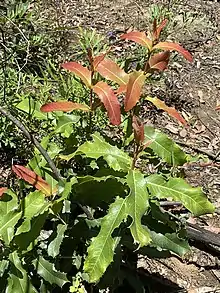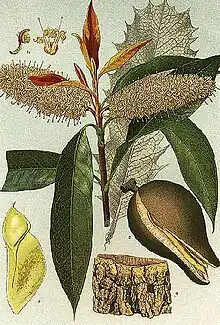Xylomelum pyriforme
Xylomelum pyriforme, commonly known as the woody pear, is a species of plant in the family Proteaceae native to eastern Australia. It grows as a large shrub or small tree to five metres high.
| Woody pear | |
|---|---|
 | |
| Woody pear at Muogamarra Nature Reserve, Australia | |
| Scientific classification | |
| Kingdom: | Plantae |
| Clade: | Tracheophytes |
| Clade: | Angiosperms |
| Clade: | Eudicots |
| Order: | Proteales |
| Family: | Proteaceae |
| Genus: | Xylomelum |
| Species: | X. pyriforme |
| Binomial name | |
| Xylomelum pyriforme | |

Taxonomy
Xylomelum pyriforme was first documented at Botany Bay in 1770 by Joseph Banks and Daniel Solander,[2] who gave it the (unpublished) binomial name Leucadendroides pyrifera in Banks' Florilegium.[3] It was first formally described as Banksia pyriformis by German botanist Joseph Gaertner in 1788 in De Fructibus et Seminibus Plantarum.[4] It was given its current name in 1809 by the gardener Joseph Knight in his On the cultivation of the plants belonging to the natural order of Proteeae.[1] The species name "pear-shaped" is derived from the Latin words pyrus "pear" and forma "shape".[5]
Description
Xylomelum pyriforme grows as a large shrub or small tree, usually reaching 4–5 m (13–16 ft) high,[6] although trees to 15 m (49 ft) have been recorded in the Howes Valley northwest of Sydney.[7] The large juvenile leaves have dentate (toothed) margins with 6 to 11 teeth along each edge, while the adult leaves have entire margins. The prominently veined leaves measure 10 to 20 cm (3.9 to 7.9 in) and are up to 5 cm (2.0 in) wide. They are glabrous (smooth) and dark green.[6] New growth is covered in a fine rust-coloured fur.[8] Flowering takes place from September to November, peaking in October.[7] The inflorescences measure 5 to 8 cm (2.0 to 3.1 in) and are rusty coloured.[6] Flowers are followed by the development of the large, woody, pear-shaped seed pod which is up to 9 cm (3.5 in) long and 5 cm (2.0 in) wide.[8]
Distribution and habitat
The plant's range is from the New South Wales mid-north coast south to Mittagong, with an outlying record from the vicinity of Cooma.[8] Xylomelum pyriforme grows on plateau and ridges in nutrient-poor well-drained sandstone soils in open eucalypt woodland. It is associated with such species as yellow bloodwood (Corymbia eximia), red bloodwood (C. gummifera), scribbly gum (Eucalyptus haemastoma), silvertop ash (E. sieberi), brown stringybark (E. capitellata), grey gum (E. punctata) and scribbly gum (E. sclerophylla).[7]
Ecology
Xylomelum pyriforme regenerates from a lignotuber or epicormic buds after bushfires, and can sucker from the roots.[7] It is one of a number of Australian species that require a fire to open and disperse their seeds.[9]
The fungus Giugnardia causes leaf spot, while Cephaleutos virescens is responsible for an algal leaf spot.[7]
Cultivation and uses
Rarely seen in cultivation due to the scarcity of seed, Xylomelum pyriforme seedlings grow readily but commonly quickly succumb to damping off. A plant may take 20 years to reach flowering stage from seed.[10]
Early European settlers of Australia used the tree's wood to make gun stocks.[11]
 new leaves
new leaves habit
habit illustration by Edward Minchen
illustration by Edward Minchen
References
- "Xylomelum pyriforme". Australian Plant Name Index (APNI), IBIS database. Centre for Plant Biodiversity Research, Australian Government.
- Bullock, William (1813). A companion to Mr. Bullock's London museum and pantherion. Whittingham and Rowland. p. 10.
- Diment, Judith (1984). "Catalogue of the Natural History drawings commissioned by Joseph Banks on the Endeavour Voyage 1768-1771 held in the British Museum (Natural History) Part 1: Botany: Australia". Bulletin of the British Museum (Natural History) Historical Series. 11: 1-184 [146].
- "Banksia pyriformis". Australian Plant Name Index (APNI), IBIS database. Centre for Plant Biodiversity Research, Australian Government.
- Simpson DP (1979). Cassell's Latin Dictionary (5 ed.). London: Cassell Ltd. ISBN 0-304-52257-0.
- "Xylomelum pyriforme". Flora of Australia Online. Department of the Environment and Heritage, Australian Government.
- Benson, Doug; McDougall, Lyn (2000). "Ecology of Sydney Plant Species Part 7b: Dicotyledon families Proteaceae to Rubiaceae" (PDF). Cunninghamia. 6 (4): 1017–1202 [1129]. Archived from the original (PDF) on 2009-06-27.
- Gwen J. Harden. "New South Wales Flora Online: Xylomelum pyriforme". Royal Botanic Gardens & Domain Trust, Sydney, Australia.
- Lüttge, Ulrich (2008). Physiological ecology of tropical plants. Springer. p. 328. ISBN 978-3-540-71792-8.
- Walters, Brian (2007). "Xylomelum pyriforme". Australian Native Plants Society website. Australian Native Plants Society (Australia). Retrieved 16 August 2011.
- Breton, William Henry (1833). Excursions in New South Wales, Western Australia, and Van Dieman's Land: during the years 1830, 1831, 1832, and 1833. R. Bentley.